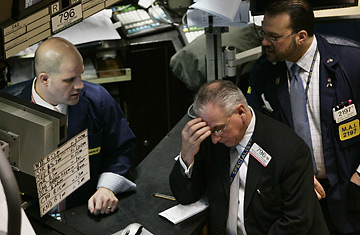
Traders work on the floor of the New York Stock Exchange, February 28, 2007.
This definition makes risk crucial to setting and understanding prices in financial markets. But we humans aren't so great at gauging risk. We pay too much heed to the recent past. We obsess over gruesome possible outcomes while ignoring the mundane but dangerous. And we often cannot envision what will happen next.
If you're looking for an explanation of the wild behavior of financial markets in recent days, this failure to get a grip on risk is as good a one as any. Many analysts attributed the mini-panic that began in Shanghai to a sudden change in investor "risk appetite." But why now? What suddenly made everybody see the future as riskier?
For a couple of years, worrywarts had been warning that investors worldwide were paying too little attention to what could go wrong. Prices of almost all financial assets were high by historical standards, and especially risky assets were especially high priced. That is, emerging-market stocks were expensive relative to U.S. stocks, small-company stocks were expensive relative to big-company stocks, speculative junk bonds were expensive relative to Treasury bonds ... you get the picture.
One of these worrywarts was Alan Greenspan-a man not known for his gloominess (or his intelligibility). In August 2005, when he was still Federal Reserve chairman, Greenspan attributed what he called "lowered risk premiums" to the economic stability of the previous decade and said higher asset prices might reflect "the increased flexibility and resilience of our economy." But he warned that investors could turn cautious at any moment and that "history has not dealt kindly with the aftermath of protracted periods of low risk premiums."
In other words, this can't go on forever. Greenspan has since delivered this message repeatedly, but markets paid no attention. Until, suddenly, they did. In a speech and question-and-answer session simulcast from Washington to conferences in Australia, Hong Kong, New Zealand and Singapore on Feb. 26, the former Fed boss repeated his concerns about risk and mentioned in passing that a recession was "possible" in the U.S. later this year.
That made headlines around the world. The next day prices on the sizzling Shanghai stock exchange-which lots of people had warned was overpriced-fell 8.8%. Stock prices began dropping in Europe, then in the U.S. There was a perfectly rational pattern to the way prices tumbled: emerging-market stock prices fell more than those in developing countries. Small stocks lost more value than big stocks. Junk-bond prices fell while Treasury bonds rose. But why then?
Some pointed to troubles in the mortgage business, others to disappointing manufacturing data, yet others to that Greenspan speech. "Our minds are ... capable of mounting explanations for all manner of phenomena, and generally incapable of accepting the idea of unpredictability," writes derivatives trader Nassim Nicholas Taleb in his soon-to-be-published book The Black Swan: The Impact of the Highly Improbable.
That's one way of looking at it. Another is to observe that while changes in risk appetite may not be predictable, they do follow a certain logic. "We view financial risk much like popcorn popping in a microwave," Merrill Lynch investment strategist Richard Bernstein wrote in January. "Until the first kernel pops, one tends to believe that nothing is happening. The initial pop seems like a random event until a second occurs. A third. A fourth. Then the popping goes wild."
Once the market popcorn starts popping, it keeps popping. Volatility begets volatility. And on the flip side, calm begets calm. The really interesting times in financial markets come when we make the transition from one to the other. We may be living in interesting times.
